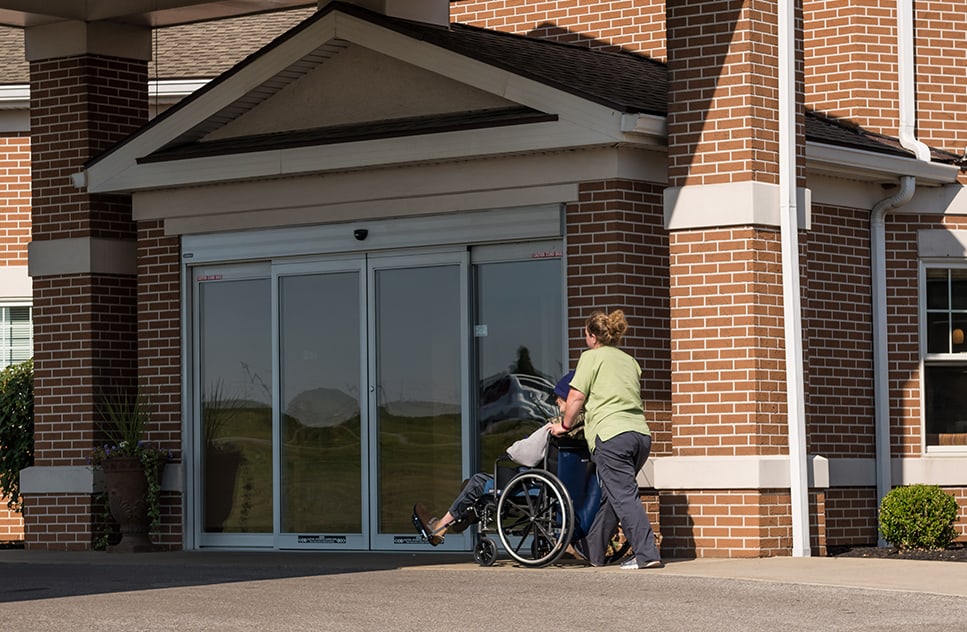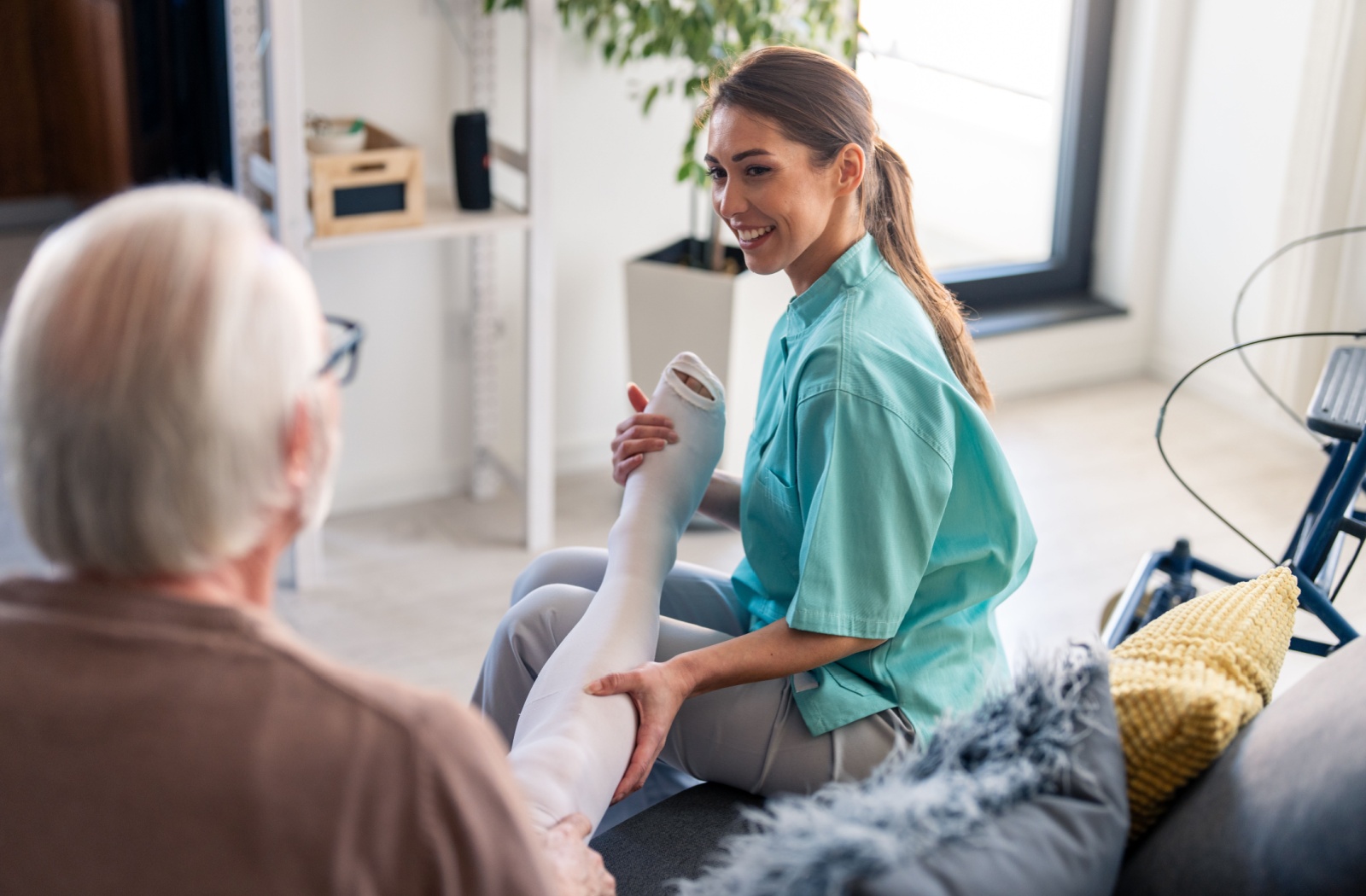Knee pain can affect every step you take, whether it’s an old injury, a recent accident, or a chronic condition that causes your discomfort. For many older adults, this discomfort can make even simple activities like walking or sitting for long periods a challenge.
Finding safe, practical ways to maintain independence and ease this discomfort can make a big difference in daily comfort and independence.
Compression socks can help with knee pain. They improve circulation, reduce swelling, and provide light support for the muscles and joints. While these handy socks aren’t a cure-all, they can be part of a broader plan for relief.
Combined with other strategies, compression socks can help you stay active and enjoy an improved quality of life.
Knee Pain: Acute vs. Chronic
Knee pain generally falls into 2 main categories: acute pain and chronic pain. Acute pain develops suddenly—often after an accident, fall, or sports-related injury. It can be intense and typically requires prompt care.
Chronic pain builds over time, often due to conditions like arthritis or long-term strain on the joint, including a lifetime of cumulative damage or aches from old injuries.
Recognizing the type of knee pain you have is a crucial first step in choosing the appropriate treatment. Acute issues may need short-term interventions like rest or therapy. However, chronic conditions often benefit from ongoing management and support.
The Common Causes of Knee Pain
Knee pain can stem from a variety of conditions. Over the years, the joint itself naturally wears down. Without proper exercise and care, this can lead to long-term discomfort.
However, this is made worse by conditions like:
- Osteoarthritis, which causes gradual cartilage breakdown in the joint
- Rheumatoid arthritis, an autoimmune condition that triggers joint inflammation
- Patellar tendinitis, which inflames the tendon between the kneecap and shinbone
- Meniscus tears, which damage the cartilage that cushions the joint
Each of these conditions affects joint health differently. However, they can all lead to long-lasting problems and pain if left unaddressed.
How Knee Pain Affects Everyday Life
Knee pain doesn’t just cause discomfort. It can also limit your ability to enjoy daily activities. Many people experience:
- Difficulty walking short or long distances
- Trouble climbing stairs or navigating uneven ground
- Discomfort when sitting for extended periods
- Reduced participation in hobbies or social events
These changes can take a toll on mobility and independence. While physical therapy and mobility aids can help, they sometimes aren’t enough. Fortunately, even seemingly simple solutions can offer noticeable improvement—including compression socks.
What Are Compression Socks?
Compression socks are snug-fitting garments designed to improve blood flow and reduce swelling in the legs. They’re made from an elastic material and come in all lengths and sizes, making them a versatile option for managing discomfort.
Benefits of Compression Socks for Knee Pain
Wearing compression socks can provide multiple benefits for those managing knee pain. By encouraging improved blood flow, they help reduce swelling and inflammation around the joint. The improved circulation can make it easier to move comfortably and stay active.
Compression socks also provide light knee support, which may help reduce strain during walking or standing for long periods. While results vary from person to person, many older adults find that this added support can make daily activities more manageable.
Choosing the Right Compression Socks
Selecting compression socks that fit properly and offer the right amount of pressure is crucial to getting the most benefits. Too much compression can be uncomfortable, while too little may not provide the intended effects.
To find the right pair, it helps to:
- Consult a healthcare professional to determine the right level of compression
- Measure your legs later in the day to help accurately confirm a proper fit
- Choose a material that suits your daily activities and skin sensitivity
- Consider whether you need features like moisture-wicking or anti-odor properties
- Check reviews and recommendations to find trusted brands with quality products
Healthcare professionals can help measure your legs and recommend a suitable compression level. This simple step can help you find the perfect fit.
Tips for Using Compression Socks Effectively
Putting on compression socks can be easier with a simple technique—roll the sock from the heel upward to prevent bunching or wrinkles. The roll-up technique helps create consistent pressure and reduces the chance of irritation.
Wearing them during activities that put strain on your knees can help maximize their benefits. For many, consistent use leads to improved comfort and mobility over time.

Other Ways to Manage Knee Pain
Managing knee pain often requires a combination of tools and strategies. While compression socks can help, they can’t do everything themselves. Try a few strategies together to find what works best for you.
Knee Braces & Supports
Knee braces provide stability to the joint to reduce strain during movement. They’re ideal for chronic pain, injury recovery, or added support during physical activity.
Foam Rollers & Massage Tools
Foam rollers and massage tools can help relieve muscle tension and improve circulation around the knee. Regular use can enhance mobility and reduce discomfort.
Low-Impact Exercise Equipment
Low-impact exercises strengthen the muscles supporting the knee without putting stress on the joint. Resistance bands and stationary bikes are excellent options for building strength and improving mobility.
Cold & Heat Therapy
Cold packs reduce swelling and inflammation, especially after an injury or flare-up. Heat packs, on the other hand, soothe stiff joints and improve circulation. Alternating between cold and heat therapy can provide balanced relief.
Stay Active & Comfortable with the Right Knee Pain Solutions
Managing knee pain often requires a combination of personalized strategies. While compression socks are one helpful part, a comprehensive approach is key. With tools like braces, gentle exercise, and therapy, you can work towards a healthier and more mobile life.
Knowing where to start is often the trickiest part—but our team at Kingston of Ashland is here to help you get off on the right foot.
In our community, we always support residents when problems like knee pain or mobility concerns arise. Our team has trained to offer just the right level of support to make independence more achievable than ever.
Schedule a visit with us today to learn more about how we can help!






